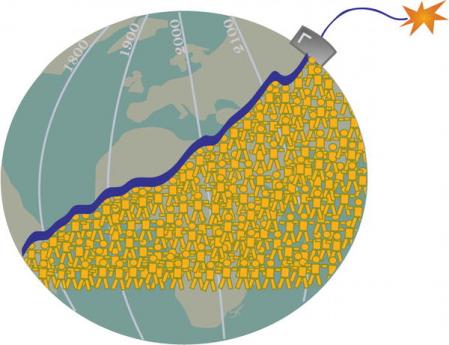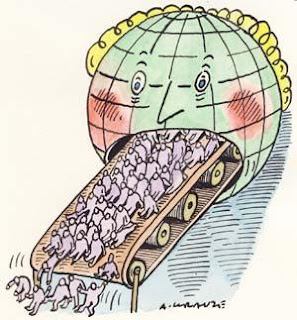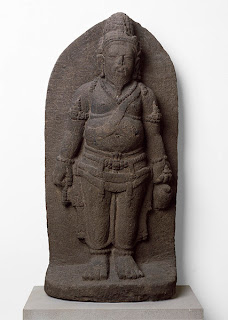
Population Explosion: Oldest Reference is in Hindu Scriptures!
The oldest reference to a population explosion issue is in Hindu scriptures! The first people to discuss a population issue and suggest a solution is in Kandha Puranam and Tiruvilayadal Puranam, books about Lord Skanda and Lord Shiva blessing their devotees. Though they were written in 12[SUP]th[/SUP] and 17[SUP]th[/SUP] centuries by Kachiappa Sivachariar and Paranjothi Muni, the issue discussed by the authors was already in Sangam Tamil literature and its commentaries.
When Shiva married Uma a big crowd assembled in the Himalayas to see the holy wedding. The weight of such a large gathering in one place tilted the balance of ‘the earth’. Immediately Shiva asked Agastya, a great sage, who was associated with Tamil language, to go to the South. When he resented that he was going to miss the beautiful wedding, Shiva promised him to ‘show’ it to him in the South. The reason for this was the population explosion in one area!
Agastya saw Shiva’s wedding at Kutralam in Tamil Nadu.
It is very interesting to note that such a population issue existed in the ancient world. Not only it was discussed, but a solution was also suggested, accepted and executed. Agastya moved southward with 18 tribes. They settled down in various places along the route. We have enough proof in literature and inscriptions to show that this was known throughout India even before 12[SUP]th[/SUP] century.
Scholars misled by foreign writers interpreted this as “Aryan migration” to the South around 7[SUP]th[/SUP] or 9[SUP]th[/SUP] century BC. But anyone familiar with Ramayana and Mahabharata would know that early contacts existed even before Agastya’s time. By fifth century BC, Vijayan of Sri Lanka married a Pandya princess from Tamil Nadu according to Mahavamsa. Parasurama was associated with Kerala and the islands beyond India.
Sangam Tamil literature has an indirect reference to Agastya’s visit in Purananuru verse 201. A revolutionary Brahmin poet by name Kapilan boldly opposed the three powerful Tamil kingdoms, shattered the caste barriers and took two Kshatriya (non Brahmin) daughters of the Chieftain Pari in to his protection. He took the girls from one chieftain to another begging them to marry the girls. When he met Irungovel, a chieftain, he says to him : “You are the 49[SUP]th[/SUP] king in your generation, who originated in the fire pit, moved from Dwaraka (Gujarat)”.

Nachinarkiniyar, the greatest of the Tamil commentators, who wrote voluminous commentaries on most of the ancient Tamil anthologies, commented that this was a reference to Agastya coming to south with 18 tribes. This proved that the Purana reference was nothing new. But the books explained the reason for southward movement-- a population explosion! He made the comment in two more places in his Tolkapiam commentary. No one can dismiss Nachinarkiniyar, bcause we have continuous references to Agastya’s association with lot of monuments from Vindhyas to South East Asia. There is a continuity in Tamil and Sanskrit literature from Rig Veda to Subramanya Bharathy—continuity for at least 3500 years ! Kalidasa in His Raguvamsa Kavya referes to Pandyas and in the very next sloka to Agastya.
( Please read my earlier posts: 1. Did Agastya drink ocean? in ‘Is Brahmastra a Nuclear Weapon’?2. Ancient Engineers of India 3. How old is Indian civilization? )
Nobody knew when Shiva married Uma at Kailash in the Himalayas. The theme was in Kalidasa’s poem Kumarasambhava. One must remember that South India was already populated even before Agastaya came to Tamil Nadu, according to Hindu scriptures. Archaeological and anthropological evidence is also available. One must also remember that Agastya was a Gotra name, used by all his descendants.

Picture: Agastya Statue from Java, Indonesia displayed at London V and A Museum.
The earliest known Agastya was in Rig Veda who married Lopamudra. He lived at least 400 years (20 generations) before Rama according to Pargiter. One of the later Agastyas conquered South East Asia and married a local woman Yasomati. We have other Agastya Siddhas who are associated with Tamil medicine and astrology. So the word Agastya should be treated like Shankaracharya, Pope, Dalailama etc. It is not one single person. The pre independent trend in India was to see the ‘ghost of Aryan-Dravidian division’ in each and every word! It was not supported by Tamil or Sanskrit books. They say that both Asuras and Devas are the children of same mother and father. They even go to the length of explaining how they were separated as Devas, Asuras, Nagas, Gandharvas, Rakshsasas, Kinnaras etc.
Agastya took people not only to Tamil Nadu, but also to South East Asia. Now we get Agastya statues in Cambodia, Indonesia and other countries.
